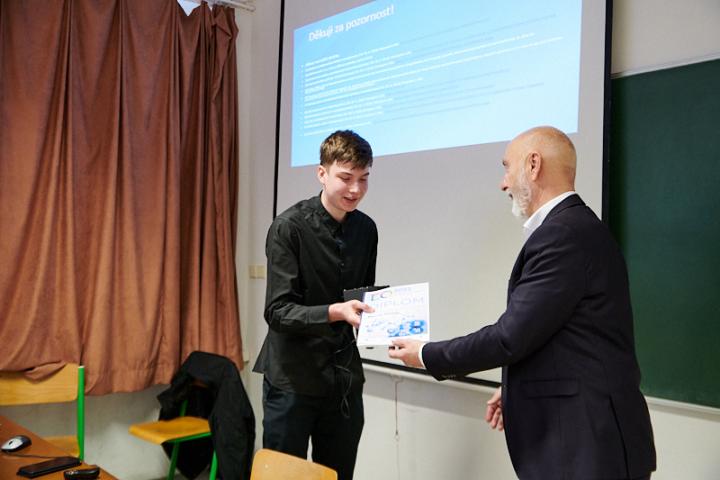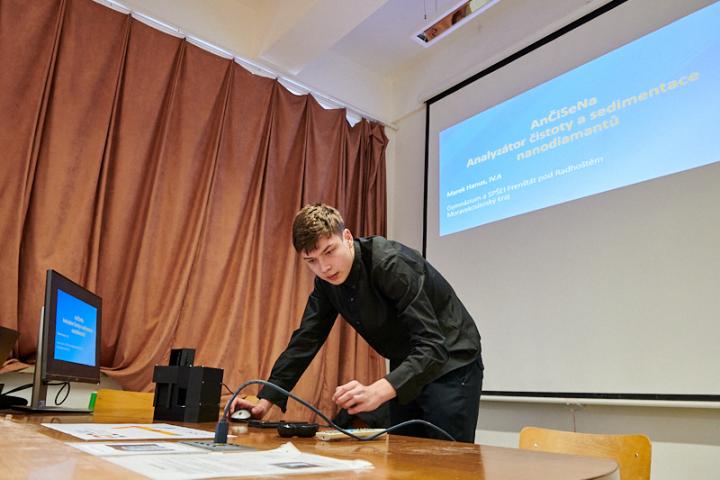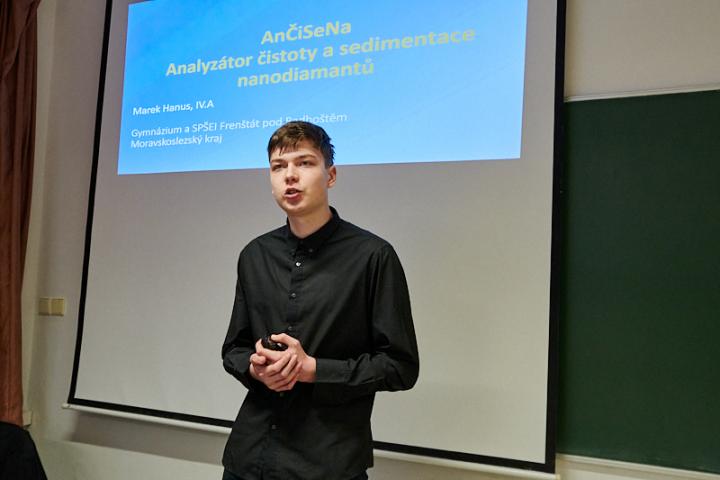
The winning work was created during a joint project of several companies and research institutions focused on the synthesis of nanodiamonds and the evaluation of their properties.
"The main objective of the winning entry was the design and construction of a system for determining the concentration of impurities, specifically graphite, and the sedimentation process in a sample of nanodiamonds. The jury appreciated that the research of the high school student already has a practical benefit," said the guarantor of the Electrotechnical Olympics, Professor Dušan Maga from the Department of Telecommunication Engineering at Faculty of Electrical Engineering.
"My work is related to the CARAT project, which deals with research on different types of carbon nanoparticles, in which a consortium of several institutes of the Academy of Sciences, universities and companies - one of which my parents work in," Hanus said. "They gave me the 'homework' to check on a simple model whether colorimetry with computer image evaluation using OpenCV libraries could be used to determine the purity of nanodiamonds contaminated with small amounts of graphite. To our surprise, this simple and inexpensive method proved to be much more accurate and sensitive than previously used instrumental methods such as XRD," the student described.
A material with a wide range of applications
Nanodiamonds are extremely small diamonds, comparable in size to viruses. They have high hardness, a very high refractive index and considerable thermal conductivity. "An interesting property is the human body's reaction to diamonds - the human body perceives them as a natural part of itself," Maga pointed out. He noted that this implies possible applications for nanodiamonds, for example in the development of modern transistors with nanostructures or in medicine, where nanodiamonds can serve as carriers for drugs or in contact lenses for the treatment of glaucoma.
Hanus worked on the nanodiamond analysis equipment for about seven months. "The most challenging part was creating a program running on a Raspberry Pi 4 that can evaluate the purity of the nanodiamonds in real time from continuously taken photographs and also their sedimentation stability," the young researcher recalled. He explained that the photos from the camera attached to the Raspberry minicomputer are converted into a greyscale pixel array using OpenCV, to which Hanus added his own algorithm, among others, to determine the height of the sediment in the tubes. "The results are then sent to a webserver and are accessible over Wi-Fi from any mobile device," Hanus added.
Hanus continues to be involved in the CARAT project. Recently, he has also developed a stepper motor controller for five peristaltic pumps for laboratory analysis and purification of nanodiamonds. "I am currently working on a program to evaluate the size of individual nanodiamond crystals from photographs of their clusters taken with an electron microscope," the student said.
More projects to be used in the field and in the company
Lukáš Rajmont's project from the Secondary School of Electrical Engineering in Úžlabina, Prague, which came second, will soon be used in the field. Rajmont presented a digital radio transmitter to the jury. "Apart from technical problems, he also coped with legislative ones and the result of his three-year work is a device that will be experimentally connected to the transmitter in Líbeznice," said Maga.
Jan Nevyhoštěný, also from SPŠE V Úžlabina in Prague 10, got the bronze. "The generator designed and built by him is used in tests of electrical equipment in a specialized company," said Maga. "The generator is used to supply the inputs of the tested devices with the required defined signal and is part of a computer-controlled complex workplace," added the guarantor.
The expert jury selected nine remarkable high school projects in the field of electrical engineering for the final of the 2022 Electrotechnical Olympics. "Unfortunately, at the last minute, one of the finalists had to cancel his participation, so in the end eight students presented eight works," Maga pointed out.
According to Maga, the unpresented project, a six-axis robotic arm, was one of the most interesting works. "The arm has the potential for use not only in industry, but also in biomechatronics, for example in the creation of intelligent prosthetic elements for disabled people," Maga explained. The author of the innovative arm, Ondřej Váňa, is also a student of the Secondary School of Education in Úžlabina, which is also one of the faculty schools of the Faculty of Electrical Engineering.
The Electrotechnical Olympics has been organized by FEL CTU since 2013. The aim of the competition is to popularize the study of technical fields among high school students. The winners of the first three places are guaranteed admission to FEL CTU without entrance exams.

